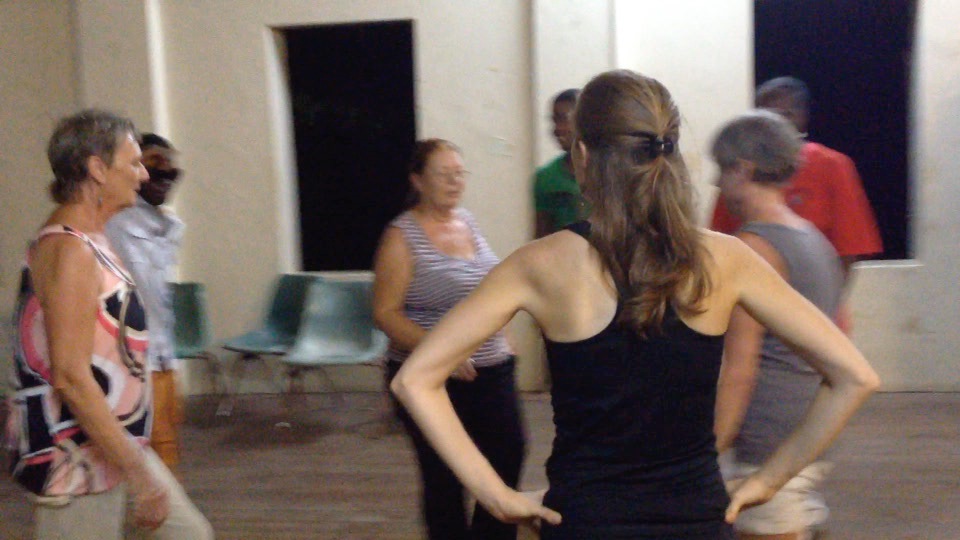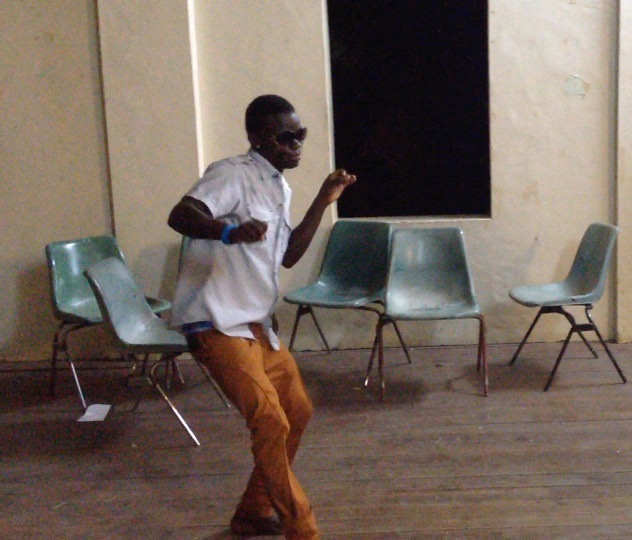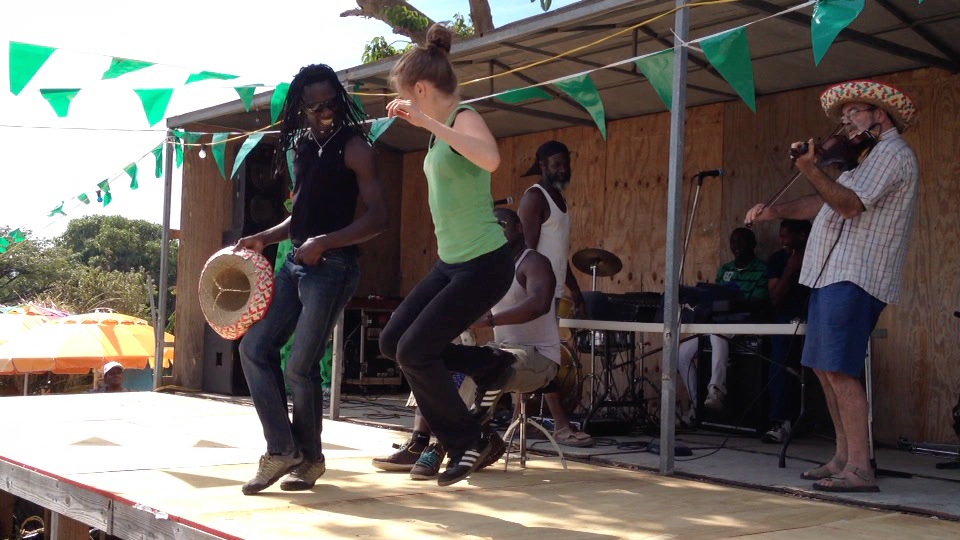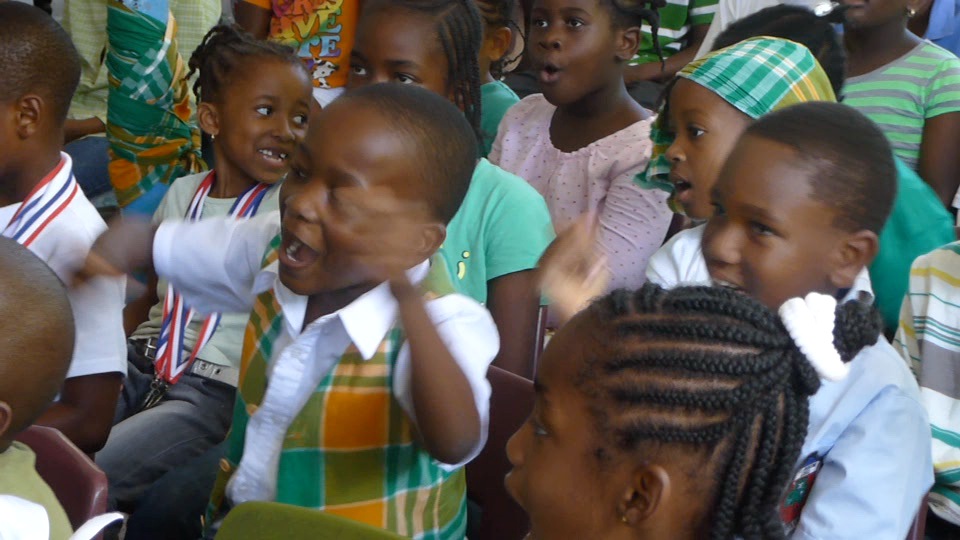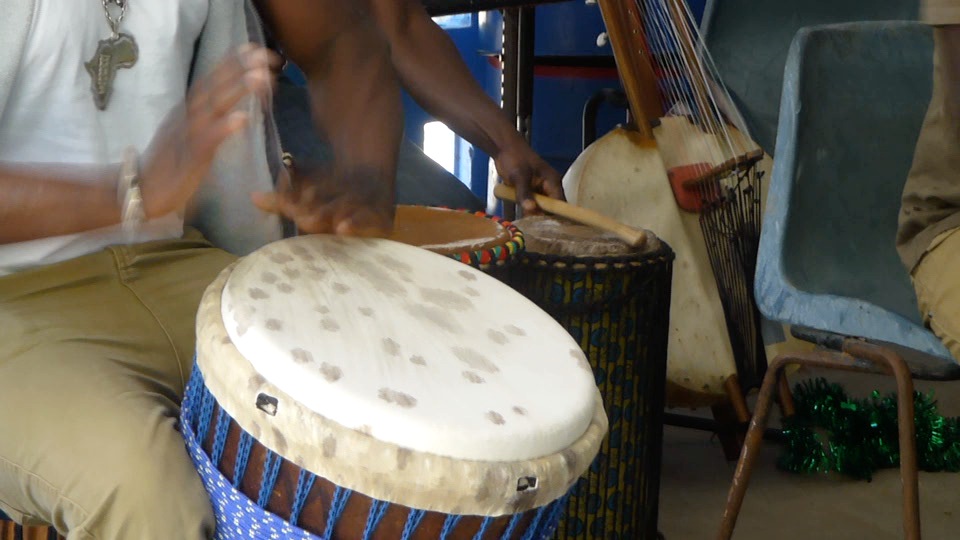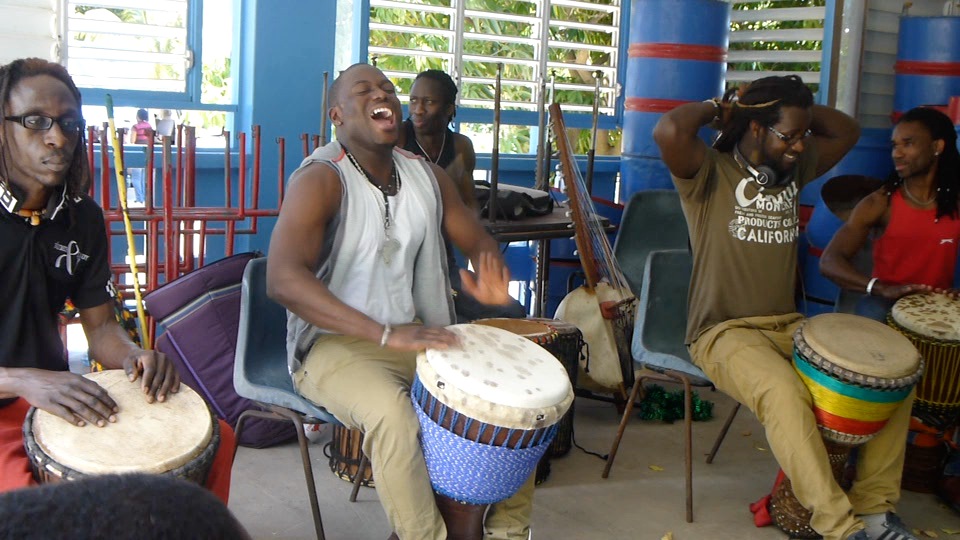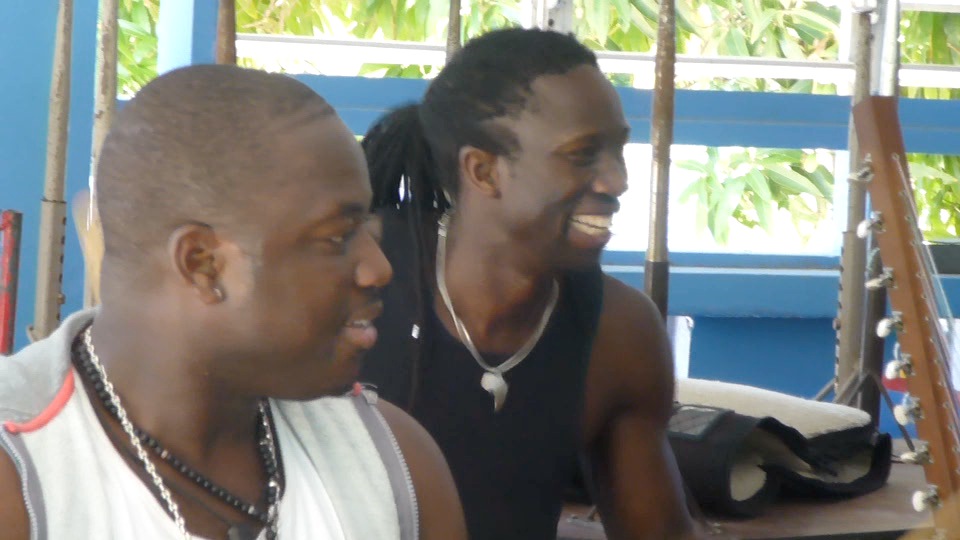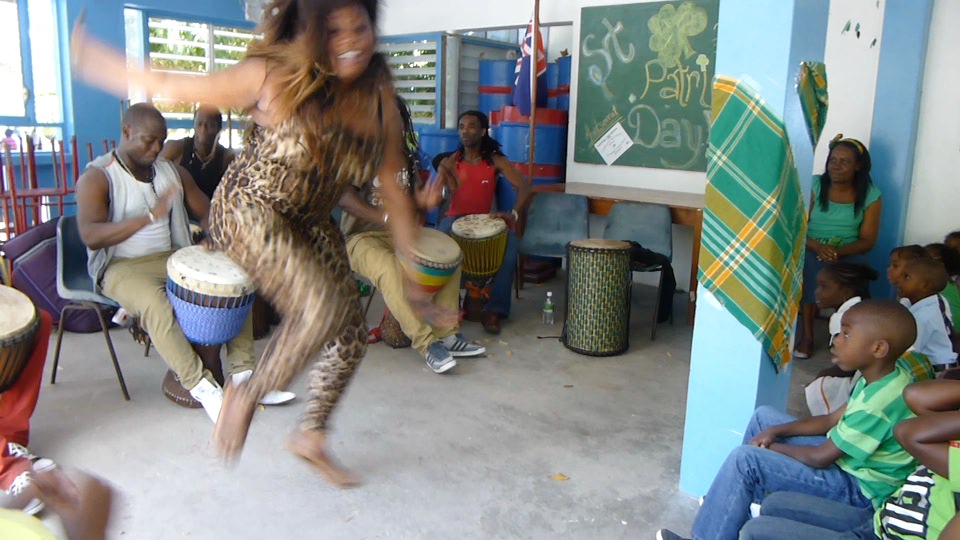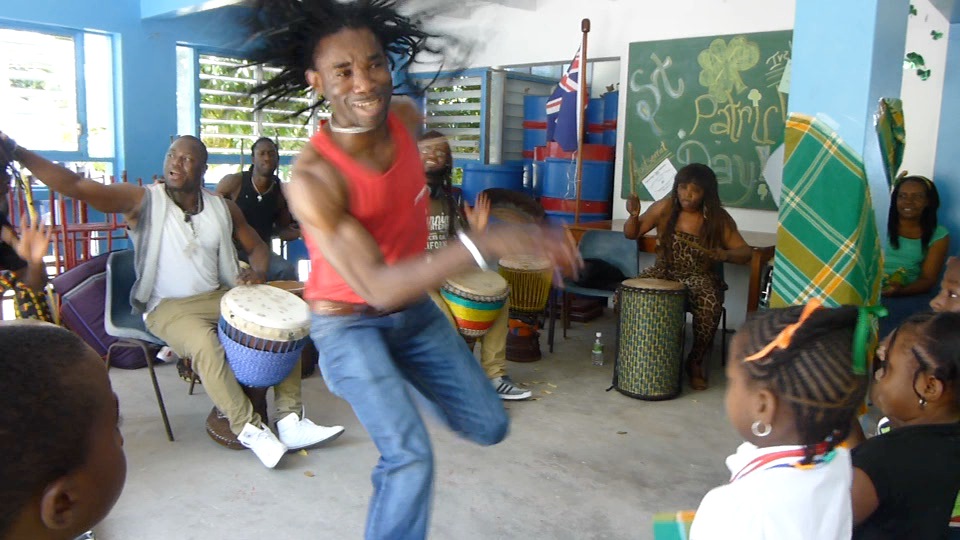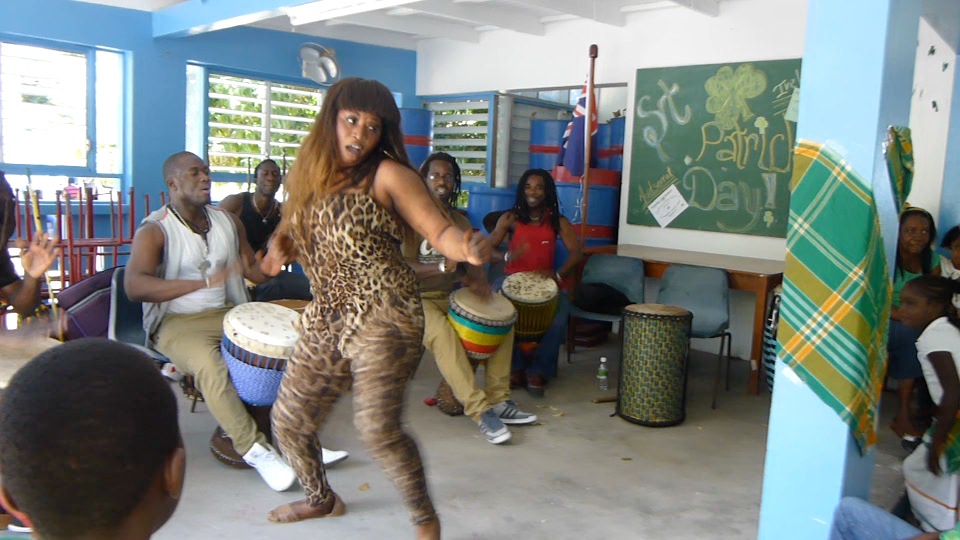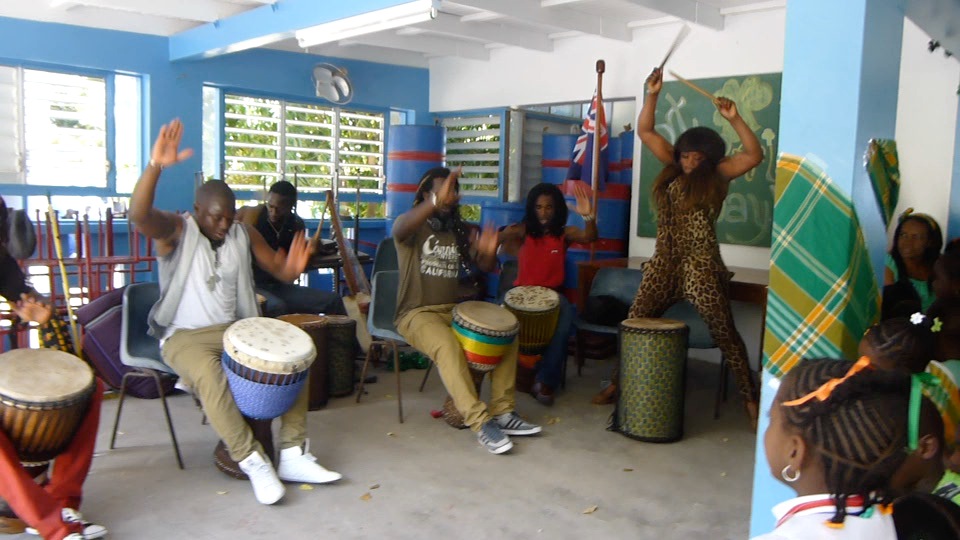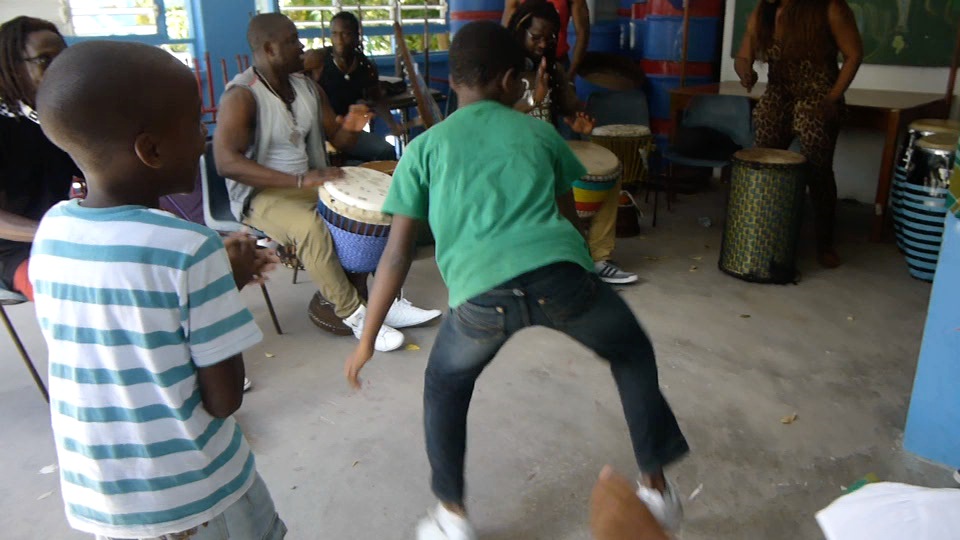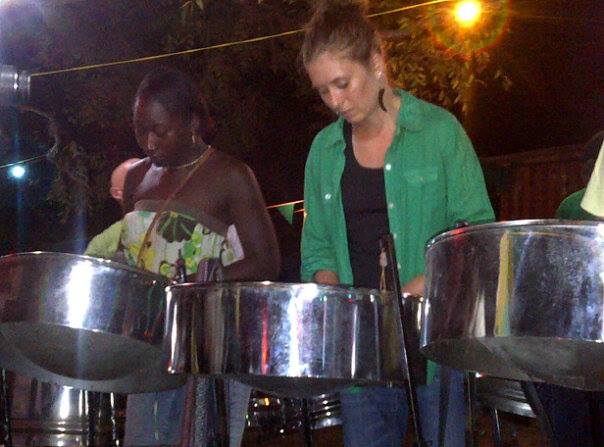Category Archives: Montserratian Dance
Adult dancers heat things up with the Bonfire dance
This evening we started with small numbers, but ended up convincing some of the guys who play basketball outside to join us. (We spied them imitating the dance in the doorway, so we invited them in, and it didn’t take much to persuade them!)
We had fiddler Mike Evans in the house again this week, this time playing reels for the Bonfire céili dance. This is a good dance for social interaction, as you move around the circle and dance with a new partner every time. The figures are a bit more complicated than those we’ve done in previous dances, and the circular nature of the dance was also new.
Trivia: the Bonfire is the only céili dance that has a figure named after a flower: the “rose,” when the ladies go in the center and gents stay on the outside circle, and then vice versa. When on the outside circle, the “book” (that is, Ár Rincí Fóirne) states that the dancers should wait in a pose with the left hand on the left hip and the right foot pointed forward with knee slightly bent. However, the boys got a little more creative. They decided to add some “vogue” poses every 2 bars, and I think I saw some Latin dance moves in there too.
I had come straight to the Irish dance class from a masquerade dance rehearsal with Montserrat’s Ladies of Alliouagana troupe. It is interesting to see how similar the quadrille formations are to céili dancing, and they also feature a one-two-three step. However, instead of hopping and standing erect and upright, the step is more of a shuffle with an emphasis down rather than up, and the posture is slightly bent over. We went through 5 quadrilles, one after the other, with lots of hooked arms, ladies chains, and arch-like formations. Not to mention the famous heel-and-toe step that is supposedly related to the Irish polka!
It was a wonderful (sweaty!) evening of blended rhythms, going from Montserratian to Irish dancing 🙂
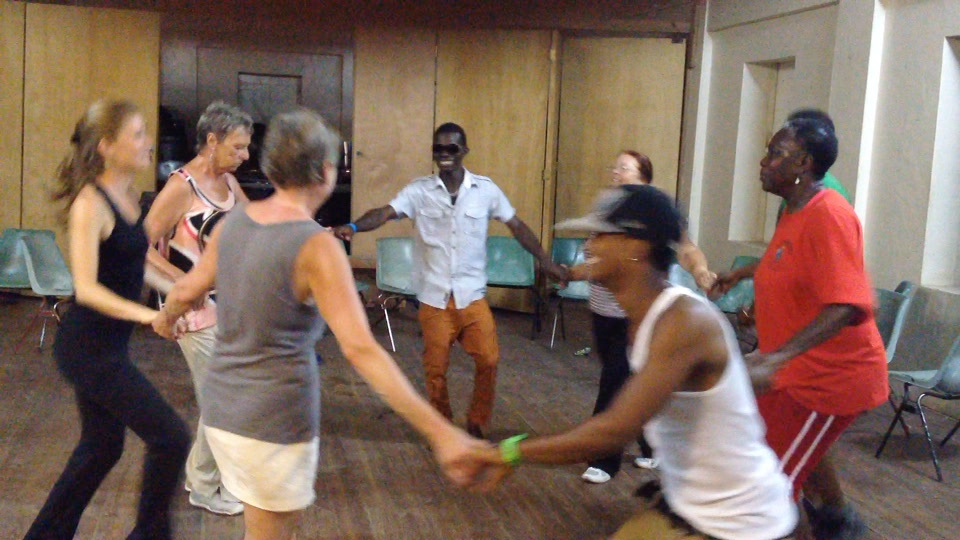
The culmination of Blended Rhythms at Montserrat’s St. Patrick’s Day Festival
This was it, the day we’ve all been waiting for! St. Patrick’s Day in Montserrat certainly did not disappoint. It was a whirlwind of activities, starting with the parade from the Montserrat Secondary School down the main road to “Heritage Village” in Salem.
The paraders gathered at MSS starting from around 1pm, and troupes included the Emerald Shamioles Masquerade Troupe (in their colorful ribboned costumes), Sankofa Garden (with their truck full of plants), Coral Cay (the local conservation research team), the Blended Rhythms Irish dancers, and Jalikunda (West African dance/drumming troupe). There were donkey rides for kids (and some adults!) and everyone was dressed in the kitschiest green “paddywhackery” you can imagine. If it weren’t for the hot sun, you might have thought you were in Dublin itself. Maybe.
Graham Clifford from the Irish Independent was there, reporting back home to Ireland about St. Patrick’s Day festivities on Montserrat. He spoke into the camera while paraders sang “Proud to be Montserratian” in the background, waving shamrocks and wooden machetes.
The groups lined up and started walking at around 2pm. I have to describe how incredible this experience was for me. The Irish dancers were between the masquerade dancers at the front and the West African drummers at the back, and so we were literally dancing to blended rhythms. We didn’t know which rhythm to follow! Both sounds kept fading in and out, and they both worked for the dancing, but the dancing had to change significantly depending on which rhythm we paid attention to.
The girls did a great job dancing, and we kept it simple: just some 3s and “sliding doors,” and we heard a few spectators exclaim, “Irish dancers!!!” The sun was bright and hot, and the road was long, but we powered through anyway. The excitement was infectious.
When we arrived at Heritage Village, we were greeted by Basil Chambers, who announced that he had no program for the day’s performances, and he would just be calling groups on stage as he spotted them in the crowd. The Blended Rhythms Irish dancers went up fairly early, and since we didn’t have time to arrange any music, we did our 3s and swings to soca music! Like the masquerade and djembe rhythms, the soca rhythm works just fine for Irish dancing, if a little off-putting at first.
The adult dancers also did a reprisal of their Siege of Carrick céili dance from Wednesday evening’s Shamrock Cabaret, and Mike Evans, visiting from the UK, played an Irish jig for us on his fiddle. We had a great time!
From there, the day was chock full of different forms of music, including local reggae, the Rude Boys String Band, a political rap, and soca. Calypso/soca King Wallace was in attendance, and I was disappointed that he didn’t give a performance of his famous “Dracula” hit from Christmas.
Jalikunda also performed again, and dancer Marietou Kouyate gathered some of the Blended Rhythms dancers together for an impromptu African dance performance! We threw on some skirts and jumped up on stage to shake it. We each did a solo as well, and you could see traces of each dancer’s background, from Haitian dance to masquerade dance to samba. It’s always the unexpected things that are the most fun!
Mike Evans also joined Jalikunda for some fun collaborations: he and Sidiki Dembelé paired up for an interesting ngoni/fiddle duet, and Landing Mané and I traded West African and Irish dance steps on stage. Marietou and Mamadou Cissokho also sang along with Sidiki and Mike for an improvised blended performance. Finally, the sound of the fiddle and djembe together lured me up on stage for some sean nós dancing, and I was joined by some others for some energetic steps on stage. It was impossible to resist!
The Volpanics and Genesis steel pan orchestras also played, and added a lot to the ambience of the afternoon. There were food stalls around the perimeter of Heritage Village, selling rotis, wraps, rice and peas, chicken, fried fish, duckna, goat water, and other treats. There was plentiful Guinness and Carib beer too, of course.
The Montserrat St. Patrick’s Day Festival was deemed a huge success, and it was a great finish for the Blended Rhythms program! We will take a week to recover and will start up a more limited schedule of Irish dance workshops next week.
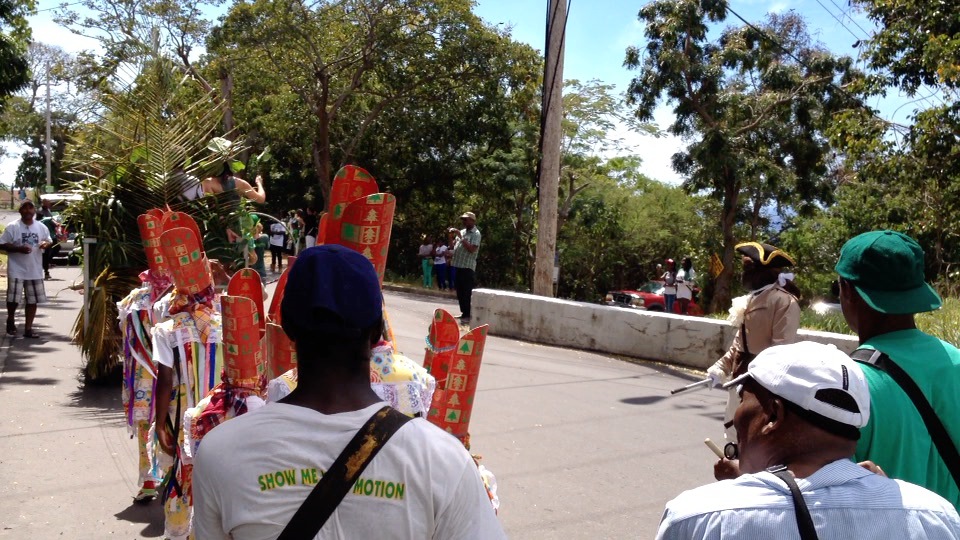
Masquerade dancers line up for the parade

Blended Rhythms Irish dancers dance in the parade
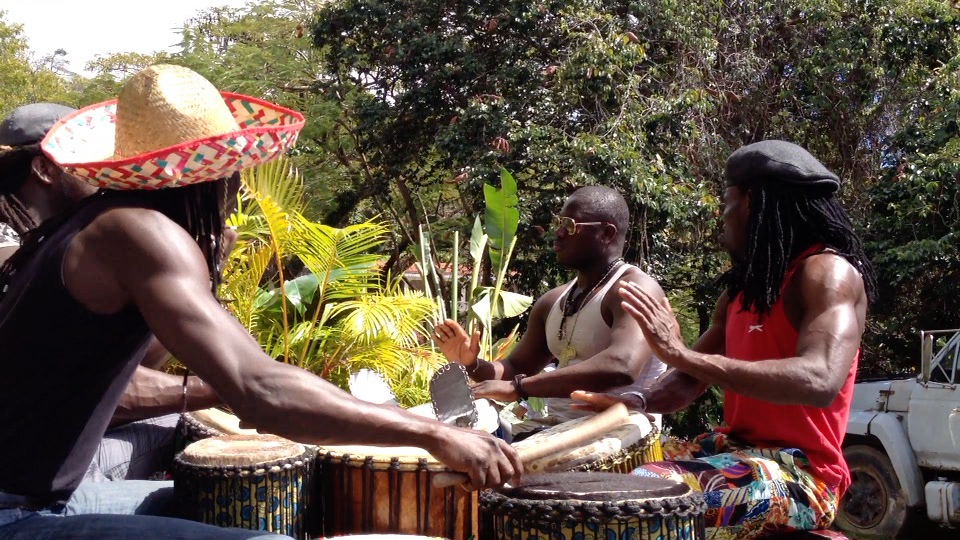
Jalikunda add some West African spice to the St. Patrick’s Day parade

Paraders arrive at Heritage Village
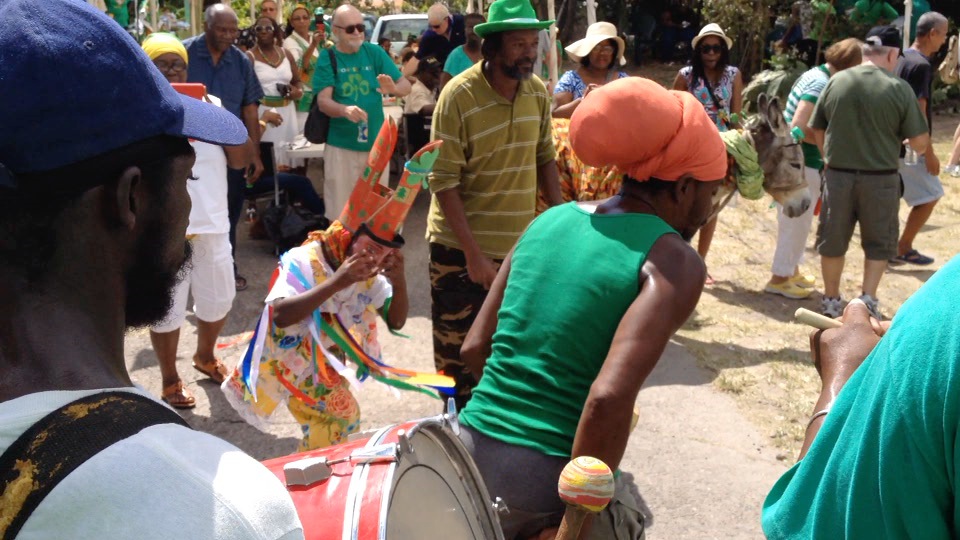
Masquerade dancers whirl up a dust storm in Heritage Village

Landing and Kate trade West African and Irish dance steps on stage with djembe player Sidiki and fiddler Mike
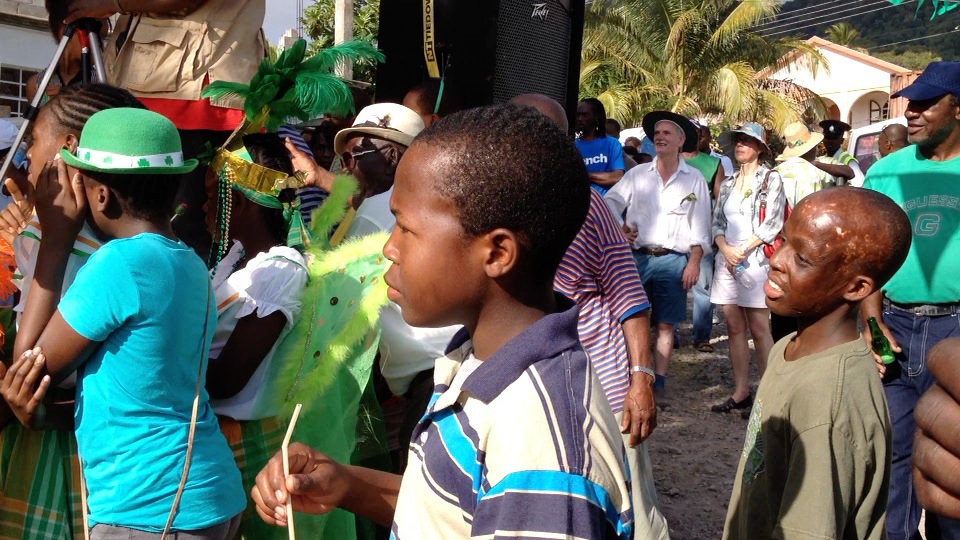
Blended Rhythms drumming students enjoy Jalikunda’s rousing performance (and see what they are working towards!)
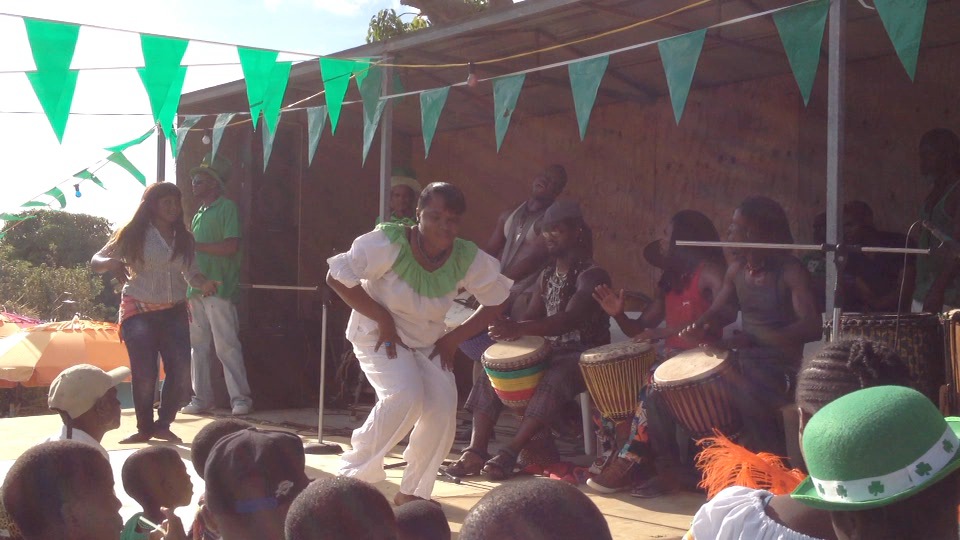
Some Haitian dancing adds a new element to Jalikunda’s West African music
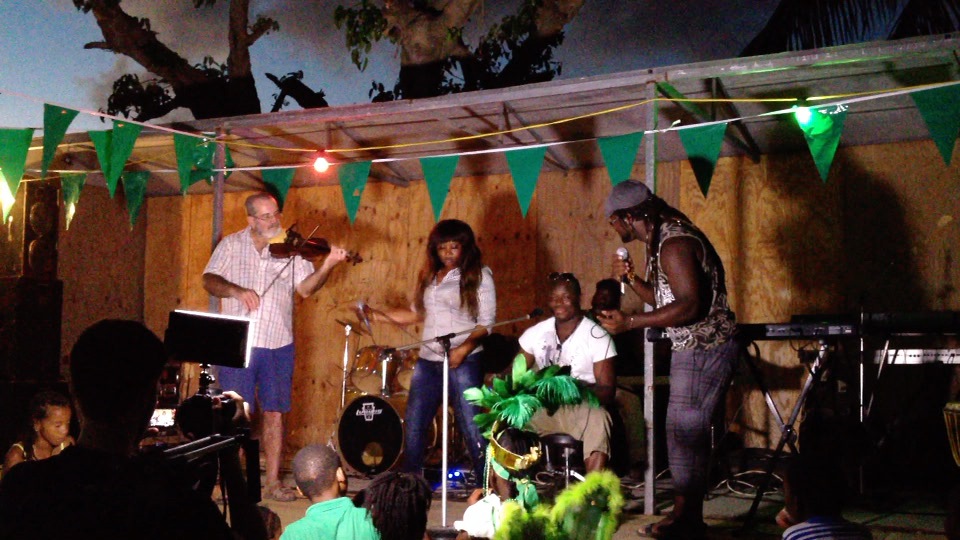
Jalikunda and fiddler Mike bring together Irish and West African rhythms on stage
Jalikunda and Oliver “Tuku” Mtukudzi get Montserrat’s schoolchildren on their feet
Yesterday the African Music Festival guest performers Jalikunda and Oliver “Tuku” Mtukudzi visited Montserrat’s three primary schools, starting at Brades, then St. Augustine’s, and ending at Lookout. They brought their energetic beats to the schoolchildren and got everyone on their feet!
Tuku brings his traditional music style from Zimbabwe, creating a chill and relaxed (but certainly rhythmic) atmosphere. The kids were swaying back and forth and bopping up and down, and a few couldn’t stay in their seats, jumping up to show off some fancy footwork.
Jalikunda’s members are based in the UK and Europe, but they hail from Senegal, Ghana, and the Ivory Coast. They offer a combination of serene lullaby-like songs with wild drumming and dancing. Band leader Mamadou Cissokho taught them a call-and-response song: “Zebele zebele, zebele zebele, zebele zebele, coco va coco wa” (pardon my spelling). Then Sidiki played an incredibly fast djembe solo that led into a tight drumming segment that brought out dancers Mariatou Kouyate, Oumar Alex Sagna, and Ernest. The children were mesmerized and then went crazy, especially when Mariatou danced!
Jalikunda tried to end their demonstration, but the students demanded more, more, more! So the band played some more rhythms and the kids rushed the stage area, losing themselves in the music.
Teacher Sarah Allen thanked the band afterwards, explaining how important it is to feel connected to their African heritage:
“The rhythm that was played this morning by the bands is the same kind of rhythm that we have here in Montserrat. When I hear the drum, I move. Whenever I hear that drum beat, it is just typical African music. And as for that dancing, Lord have mercy! I wish I was young again so I could move like that!”
Tuku and Jalikunda will both perform tonight on the big stage at Salem Park. The festival will begin at around 8pm, and be sure to be there by 8:45pm, when Blended Rhythms adult students will demonstrate the djembe rhythms they’ve learned over the past couple months!
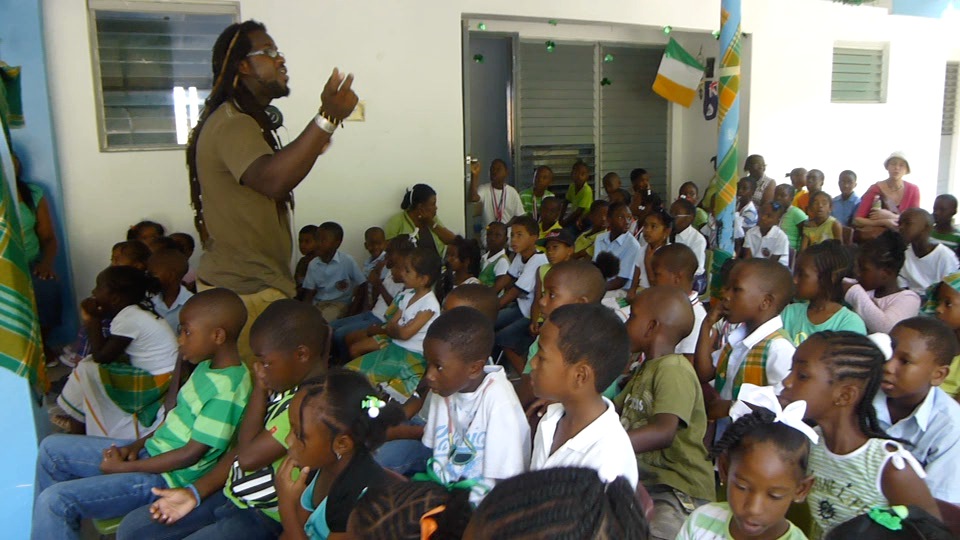
“Mommy…I hear a rhythm…get ready to jig to the drums of freedom!”
“Mommy…I hear a rhythm…Mommy…I hear a rhythm…get ready to jig to the drums of freedom!” says the radio ad for Rhythm Night this St. Patrick’s Festival 2014. And that is just what we did.
It was a rocking party at Rhythm Night in Salem last night! The Rude Boys started the evening with some string band rhythms in front of Gary Moore’s. The unique sound of harmonica with conga drum, guitar, and other percussive instruments got everyone bopping up and down and side to side. Then the Volpanics entertained with their repertoire of songs on the steel pans, including some Irish songs, such as “Danny Boy” and “Cockles and Mussels.” However, it was “La Bamba,” Arrow’s “Hot Hot Hot” and King Wallace’s “Dracula” that really got people moving and dancing. The Genesis Steel Pan Orchestra also played in front of Desert Storm.
If you wandered down to Desert Storm, you would have heard the distinctly Montserratian masquerade drumming and found a lively street jam! That is exactly what I did, and I ended up learning some masquerade steps, including the heel and toe, from my friends who are members of the Ladies of Alliouagana masquerade troupe. (They are also Blended Rhythms students!) We made our way through the street, cars honking at us as they tried to get past. Miss Goosey was hovering eerily above my head—does anyone else find her a bit creepy? (See video below.)
Next up was the Martin Healy Band playing some Irish ballads inside of Gary Moore’s. They also played some jigs and polkas that got the Blended Rhythms students on the dance floor for an impromptu jam! We did a bit of a reprisal of our Siege of Carrick dance from the Shamrock Cabaret.
Talk about a blending of rhythms! That’s what Rhythm Night in Montserrat is all about. Check out the video below to hear the eclectic range of beats!
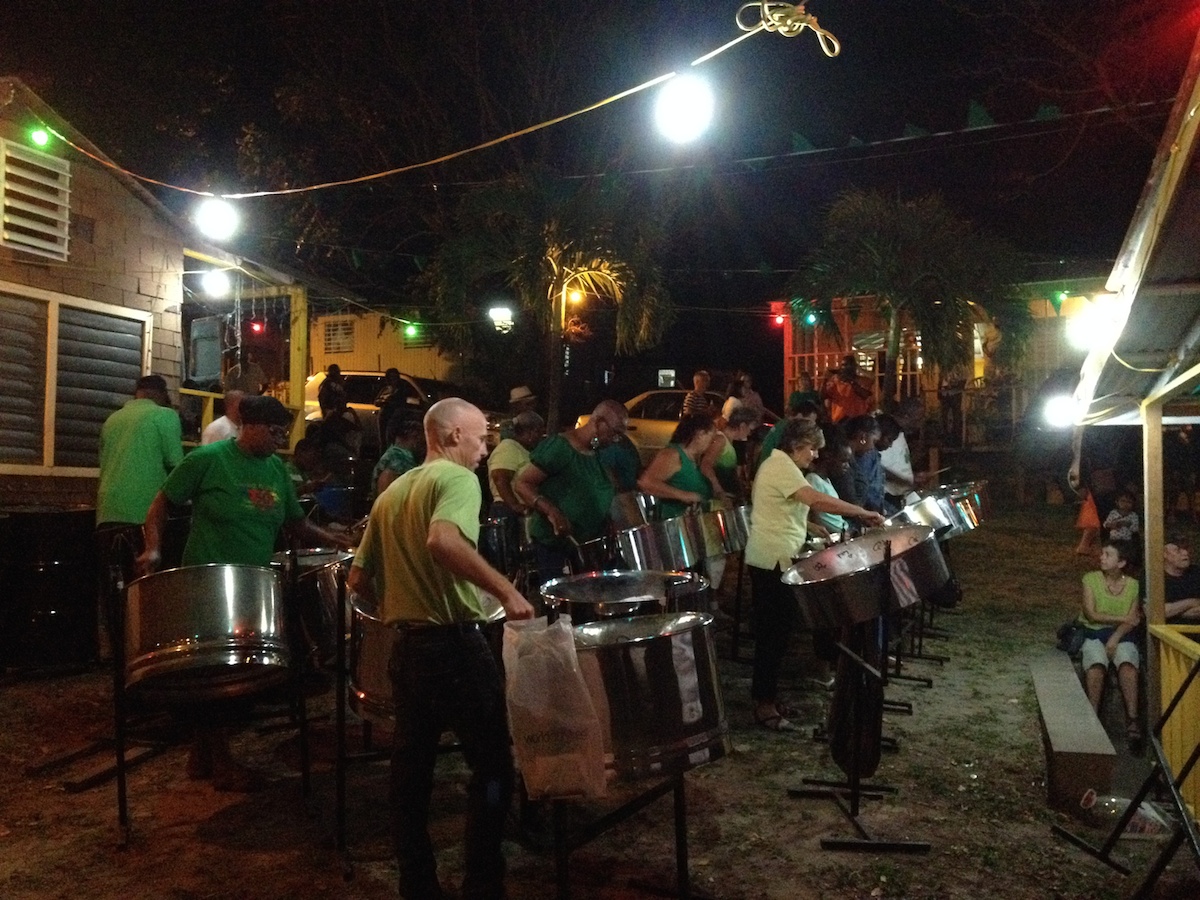
An Irish/Montserratian encounter at St. Augustine School
What a great event! The Skype call began promptly at 9:30am with the Irish and Montserratian students greeting each other via video chat. Everyone here was dressed in the appropriate colors for St. Patrick’s Day: lots of green, lots of white, and lots of national dress as well (which is a combination of Montserrat’s colors: green, orange, and white). The assembly area was decorated with shamrocks and other Irish-themed paraphernalia.
There was a lot of exchange back and forth as the students took turns asking and answering questions and talking about what their school is like. Students at Gaelscoile d’ide Primary School in Fermoy, Co. Cork told the students at St. Augustine about some of their favorite hobbies, such as hurling (an uniquely Irish sport), and about what a typical day at school is like. They also sang some songs and said some prayers.
The St. Augustine students talked about their Irish surnames—Rhonda Allen spoke by herself about her Irish surname and her interest in cooking. The students spoke some of the Irish they have learned recently, and they also sang some songs.
The dancers did a wonderful job demonstrating what they’ve learned over the past two months! They were focused and took it seriously and the céili dance looked beautiful. It was hard to know what the Irish students thought, but I’ll bet they were impressed! (See video below.)
Then the masquerade dancers demonstrated what they do, with their elaborate and colorful costumes and rousing drums. The dance is definitely similar to Irish dance, but also extremely unique.
Finally, the steel pan orchestra played a few songs. As a novice panner, I can say that these children are really good. It’s not an easy instrument and it takes a lot of teamwork to make it all work together!
Congratulations to all involved, and thank you to Graham Clifford (of the Irish Independent), Mrs. Claudia Skerritt (St. Augustine’s principal), and all the teachers at both St. Augustine and Gaelscoile d’ide Primary School. Hopefully this connection and friendship will continue!
Here are some visual highlights from the morning:
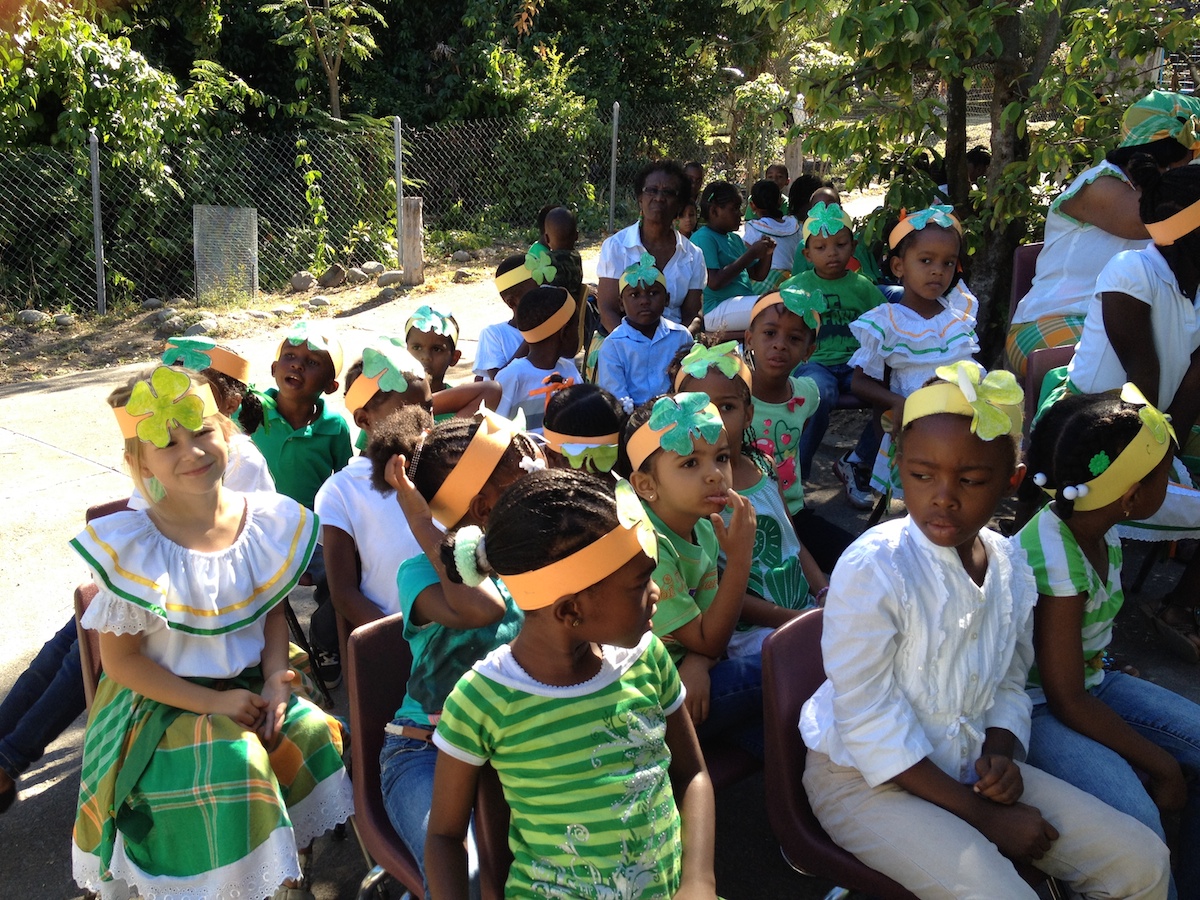
St. Augustine students sit quietly as they wait for the Skype call to begin. They are wearing beautiful colors today!
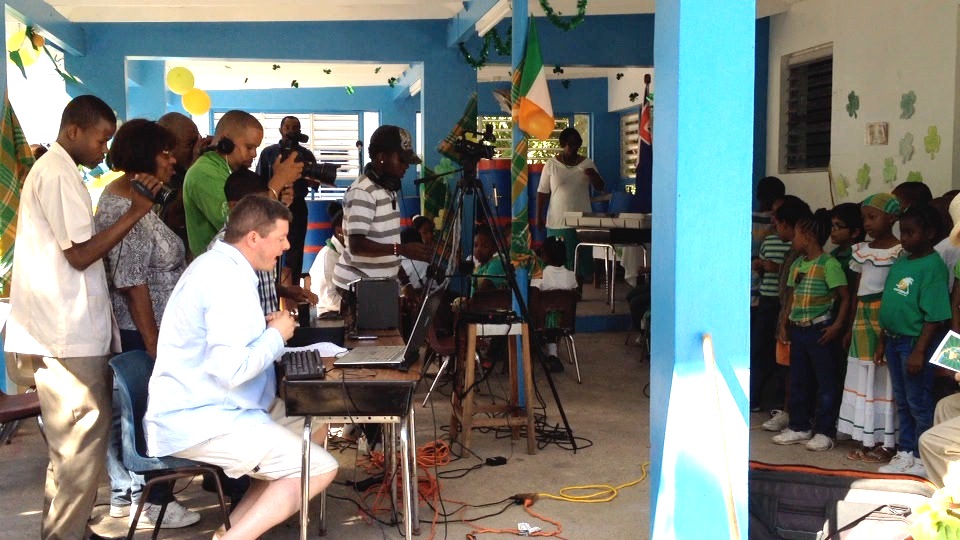
Graham Clifford of the Irish Independent newspaper sets up the Skype call on his laptop.

The young students wave hello to their new friends in Fermoy, Co. Cork, Ireland!
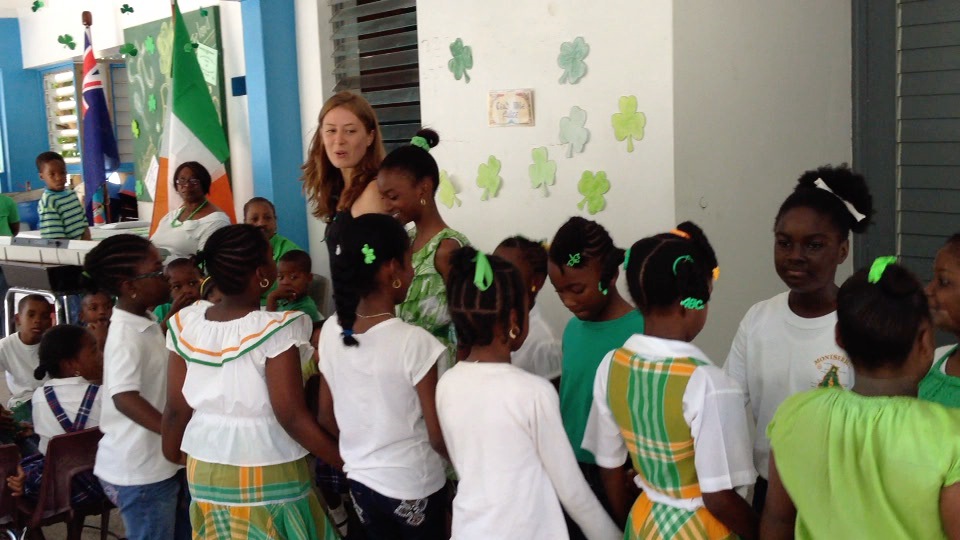
Irish dancers take center stage!
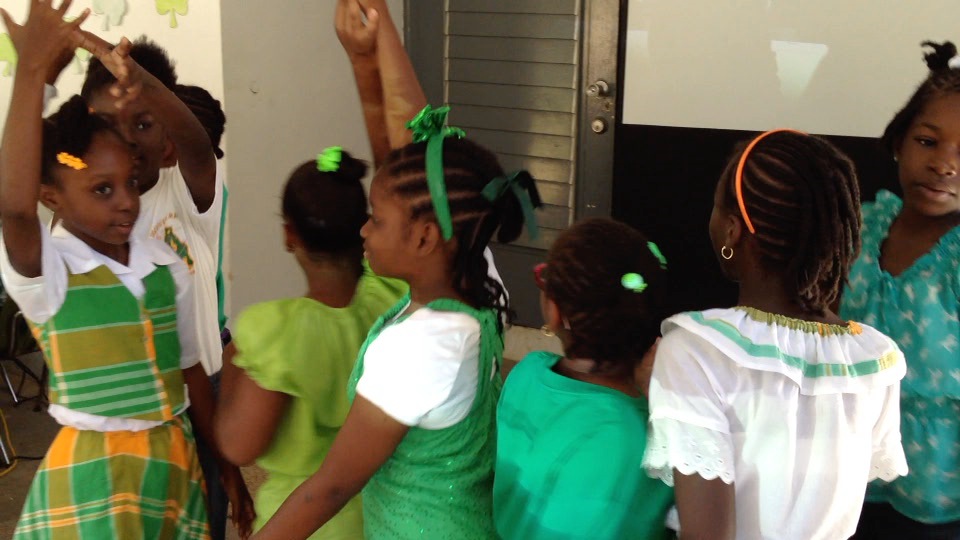
Space was tight, but this was the most successful “waves” we’ve ever done!
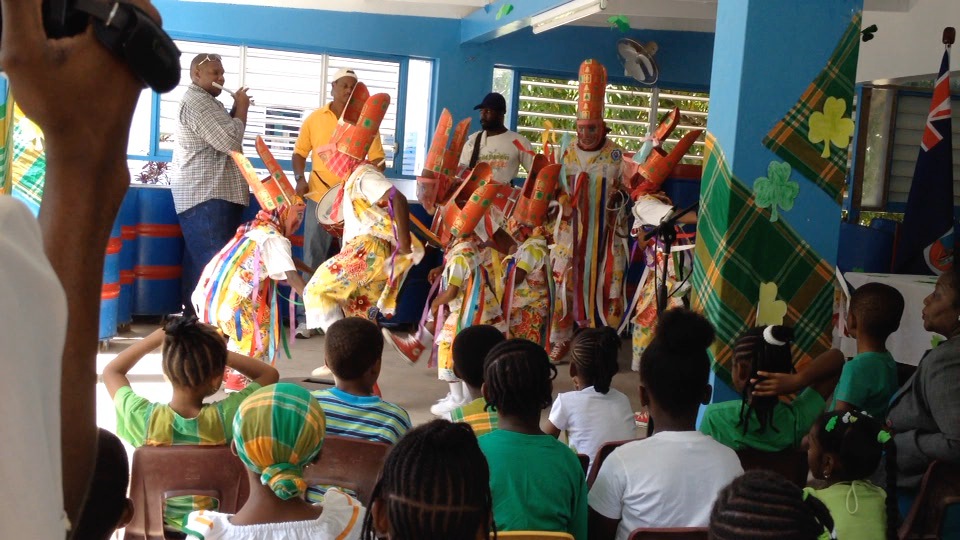
The masquerade dancers show what Montserratian traditional dance looks like—Teacher Sarah Allen describes it as a combination of Irish and African movements, but emphasizes that it is uniquely Montserratian (distinct also from the masquerade dances of other nearby Caribbean islands).
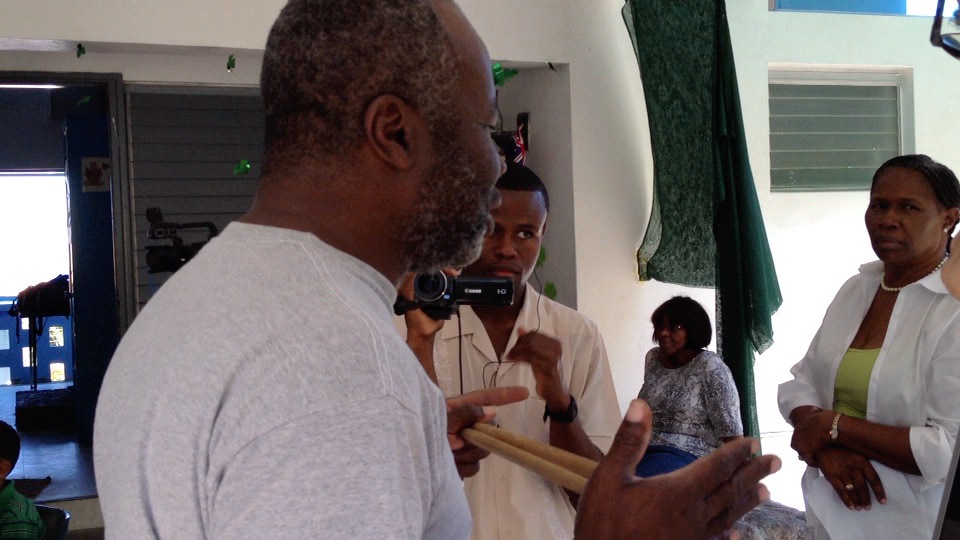
Herman “Cupid” Francis explains to the Irish students the history of steel pans.
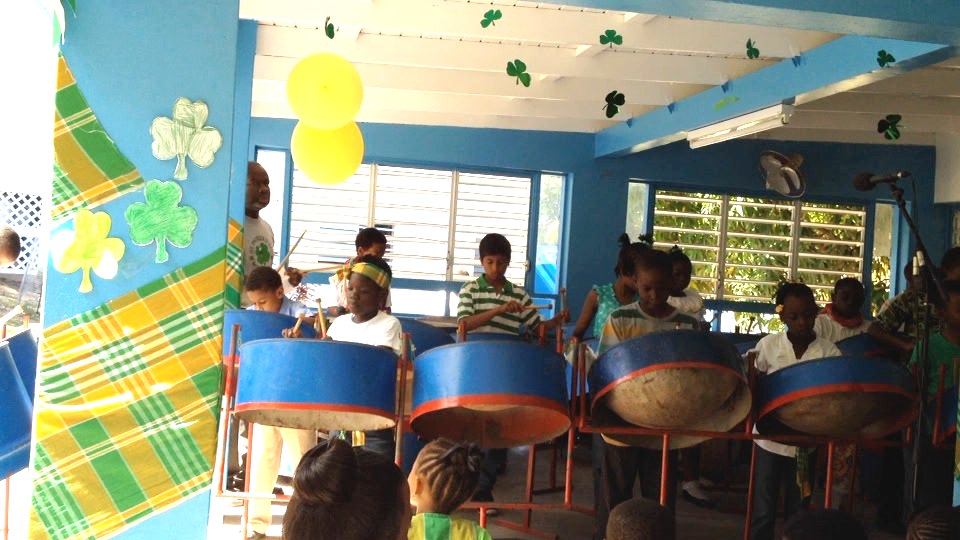
The students give an impressive performance on the steel pans!
)
Adult djembe and céili classes lead into an impromptu masquerade dance jam
We had good numbers at the adult drumming and dance classes yesterday evening, and it’s great to see that we have regulars who come every week (and are showing real progress!) as well as new faces.
We learned some new djembe rhythms (including lamba and assiko, or “high-life”), and this week we were under a bit more pressure, as each student had to play a (difficult!) rhythm pattern alone! It’s easy to play when the rest of the group is backing you up, but you really have to confront your own mistakes when playing solo. A hard but valuable lesson!
We also reviewed some sean-nós (“old style”) steps from last week, breaking down the footwork in more detail. The “basic” step is actually one of the harder steps, but once you’ve mastered it, anything is possible.
We ended with a fun céili dance called “The Waves of Tory,” which is a good interactive social dance that progresses down the floor. There were a few minor collisions, but what fun would it be without them?
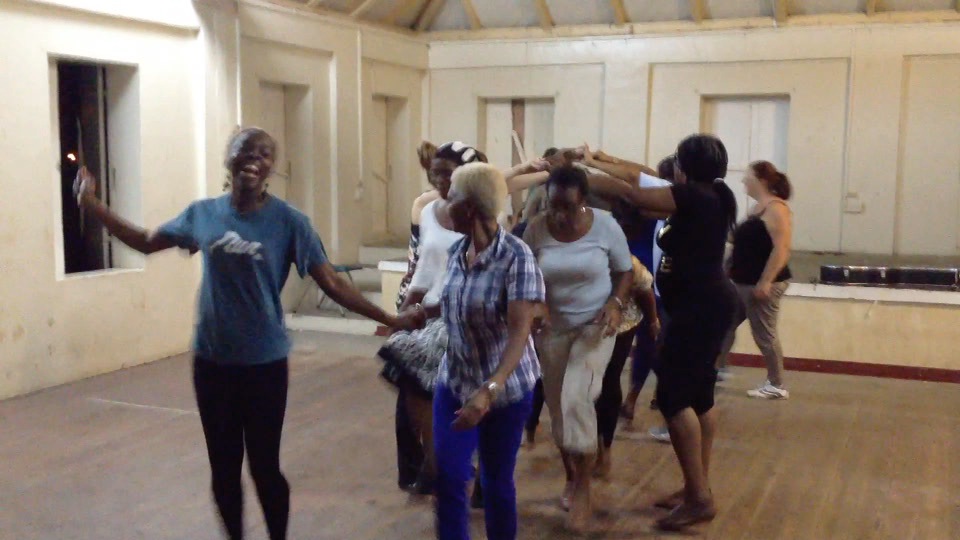
After the workshops, everyone gathered outside the school building in the basketball court. People were still dancing “skip 23s” around, and this eventually morphed into Montserrat’s masquerade dance! Some of the students are in the Ladies of Alliouagana masquerade troupe here in Montserrat, and they showed just how similar some of the steps are to Irish dance: there is a similar 3-count step, as well as a heel/toe step. Dominique pulled out his djembe and gave us a beat while we danced masquerade!
This kind of “trading” of steps and rhythms is exactly what these workshops are all about: the intersection of Africa, Ireland, and Montserrat.
Adults djembe class
Adults djembe class (audio)
Adults dance “The Waves of Tory”
Rhythms of St. Patrick’s Week
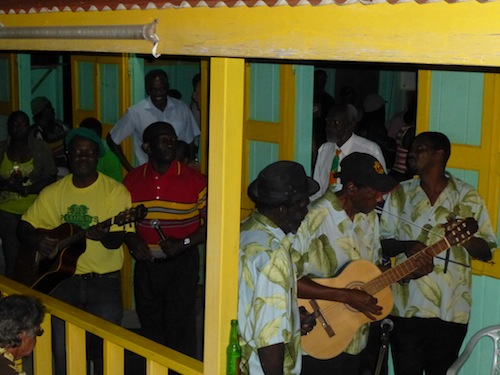 Montserrat has many local acts that perform for the St. Patrick’s Festival’s “Rhythm Night,” including the Steel Drum Ensemble, masquerade dancers in the streets, Rude Boys String Band (pictured here), and Jalikunda from West Africa.
Montserrat has many local acts that perform for the St. Patrick’s Festival’s “Rhythm Night,” including the Steel Drum Ensemble, masquerade dancers in the streets, Rude Boys String Band (pictured here), and Jalikunda from West Africa.
Continue reading

St. Patrick’s Day 2013
Communications and Projects Officer Richard Aspin explains why the African Music Festival was added to St. Patrick’s Week festivities, for the first time in 2013:
“The whole point of having an African music festival as part of St. Patrick’s week is that, in the 1700s, the slaves, the African slaves, in Montserrat, rebelled on the day of St. Patrick’s Day, March 17th, 1768, I think it was. They had a big slave rebellion, and all the slaves were hanged for rebelling against the Irish, and it was the Irish people on island who had plantations. So all these slaves worked for the Irish. So they rebelled! During a big party because of St. Patrick’s Day. So because of that, we remember St. Patrick’s Day not because of the Irish, but because of the slave rebellion, which eventually led to the freedom of the slaves.”
Here is a video of Irish dancing and West African drumming/dancing at the 2013 festival, featuring workshop instructors Kate and Dominique (with Jalikunda). We can’t wait for more and even better performances bringing together Irish and West African traditions in 2014!
If video does not play, please click here: Montserrat Irish African Dance.mov
Introduction: Montserrat Rhythms
We’ll be updating this blog with photos and videos from the workshops starting in January, so stay tuned to this site and our Twitter feed! Irish dance and West African drumming workshops will begin in the first week of January 2014. Learn more about the project here.

